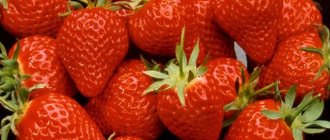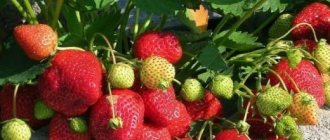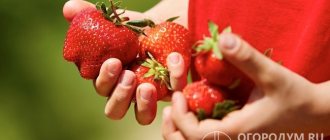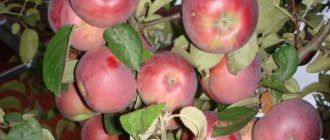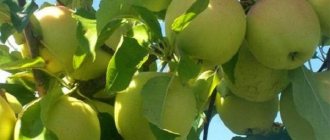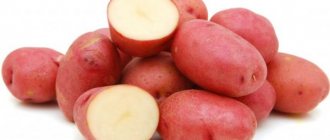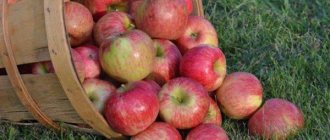In this article we will talk in detail about the characteristics of Asia strawberries and the features of this variety.
Strawberry NF 421, registered under the Asia trademark, is of Italian origin: it was bred by breeders (Cesena), uniting two well-known nurseries: Geoplant and Raji. The variety appeared on the market relatively recently, in 2005, and received a European patent (23759); included in the registers of plants approved for cultivation in Ukraine (as NF 421 in 2015) and Belarus (as “Asia” in 2021); it is not listed in the State Register of the Russian Federation.
Due to the high yield and marketability of the berries, the Asia strawberry (pictured) is suitable for amateur gardening and commercial cultivation on an industrial scale
The variety is well adapted to natural zones of mixed forests, forest-steppe and steppe, continental and temperate-northern climatic conditions. It is recommended for cultivation in open ground in Ukraine and Belarus (Brest, Vitebsk, Mogilev regions), and is successfully cultivated in many regions of Russia. It has great yield potential under film covers and in greenhouses, and shows excellent results when grown in substrate and using hydroponic technologies.
The variety shows excellent results in open and protected ground, when grown on a substrate or using hydroponic technologies
Strawberry "Asia" meets modern requirements:
- producers - by yield and disease resistance;
- retail chains - on marketability and shelf life of products, transportation and storage capabilities;
- consumers - by the attractive appearance and excellent taste of the berries, the versatility of their use.
Description of the characteristics of strawberries
Brief botanical description:
- Bushes. Large, spreading, with a moderate number of leaves and a powerful, well-developed root system. The plant forms many peduncles and rosettes. The number of mustaches is moderate.
- Leaves. Large, glossy, rich green color. Slightly corrugated, edges torn.
- Fruit. Large, one-dimensional, with a shiny, glossy surface. The shape is cone-shaped. The seeds are yellow, medium pressed. The sepal is bright green, raised. At the stage of technical ripeness, the tip of the berry retains a white-green color. Full coloring occurs at final ripening. The berries are easily torn from the stalks.
Characteristics of the Asia variety:
| Characteristics | Meaning/Description |
| Ripening time | mid-early (the first berries appear in June) |
| Bloom | in the month of May |
| Fruiting | uniform, about three weeks |
| Productivity | 1-1.2 kg per bush |
| Berry weight | the average weight of the berries is 30-35 g (in the first half of fruiting there are specimens up to 90 g; giants usually differ from standard berries in their modified shape) |
| Life cycle | 4 years |
| Resistance to diseases and pests | resistant to spotting, fungi and diseases of the root system; susceptible to powdery mildew, chlorosis and anthracnose |
| Drought resistance | high |
| Frost resistance | withstands up to -15 degrees Celsius (it is advisable to grow in greenhouses, and when growing in open ground, be sure to cover for the winter) |
| Taste and aroma | the pulp is sweet and juicy, with a bright strawberry aroma (no internal voids) |
| Tasting assessment | 4,6 |
| Purpose | universal (suitable for any purpose, including freezing) |
| Transportability | high |
| Safety | high |
We also suggest watching a video review of the harvest of this strawberry variety:
Fruit characteristics
Why do people love strawberries most? Of course, for her berries. And in this respect, the Asia variety compares favorably with many others in the shape and size of the strawberries. On average, the size of the berries can vary from 25 to 40 g, but truly gigantic specimens weighing up to 100 grams are quite common. And in general, the berries are rather large, and what is most important, with age there is practically no observed crushing of them, as in many other varieties.
The shape of the berries is also often unusual. As a rule, they resemble a truncated, slightly flattened cone, sometimes with two tips.
The color of the berries is rich, bright red, with a glossy finish. The pulp has the same color, but a more delicate shade. Internal voids are usually not observed, the density is moderate.
The taste characteristics of Asia berries are excellent.
Attention! This variety of strawberries contains a lot of sugar, so the berries can be eaten straight from the bush, enjoying its pronounced strawberry aroma.
Due to its wonderful taste, Asia strawberries are universal varieties. It is suitable both for fresh consumption and for freezing, as well as for preparing an endless number of preparations for the winter: preserves, jam, compote and other delicacies.
The berries are easily torn from the stalk. Strawberries of the Asia variety are quite suitable for long-term storage at low temperatures, as well as for transportation over long distances. In addition, berries can attract buyers with their appearance. From all of the above, it follows that the Asia variety may well be grown for sale and even used on an industrial scale.
In this video you can see the berries and strawberry bushes of Asia from all angles:
Comparison of Asia with other varieties
Compared to similar varieties - with similar ripening periods, yields and purposes, the "Asia" variety has many significant advantages:
- The main quality that distinguishes Asia from other large-fruited varieties is the absence of voids. True, subject to proper watering.
- High adaptive abilities - a variety intended for hot Italy, easily adapts to new climatic conditions.
- High yield, transportability and safety. The variety is profitable for sale.
- Can be grown in any conditions - in open and closed ground, in bags.
- Very sweet berries. They do not lose their taste after heat treatment and freezing.
- High resistance to strawberry diseases.
In the category of mid-early varieties, Asia occupies a leading position in taste. Having good transportability, Asia is inferior in this regard to the mid-early varieties Elegance, Figaro, Raurika and Roxana. The variety was inferior to them in yield.
Among the disadvantages of the Asia variety is its demands on agricultural technology. Unlike the usual, “folk” varieties, Italian strawberries require a lot of care, but their harvests are also more generous. The disadvantages of the variety also include the need for winter insulation and vulnerability to some serious diseases.
History of the variety's creation
This strawberry variety was bred by Italian breeders working in the city of Chenzena. The originators tried to develop a variety that could be grown on an industrial scale. But in Russia, Moldova and Ukraine, where this variety also began to be planted, it took root only in small subsidiary farms.
Asia strawberries were patented by Italian breeders in 2005 and recommended for cultivation in the northern regions of Italy.
Strawberry Asia - photo
How can the variety be propagated?
Strawberries "Asia" are propagated in any convenient way:
- Usami. This is the simplest, most convenient and effective method of reproduction. The variety produces a small amount of tendrils, so there is no need to remove everything. Reproduction order: Pin the rosette located near the mother bush to the soil, cut off the remaining part of the tendril. They choose the first rosette from the bush - it is stronger than the others and will produce berries for next summer.
- In August, when the rosettes take root, separate them from the bush using a disinfected knife - cut off the tendril. Then dig a rosette with a clump of soil.
- Plant the extracted seedlings for growing - in a specially designated bed, and in the spring they can be transplanted to a permanent place.
- Dig up the bush and shake off the soil from the roots.
- Soak the seeds in melt water and place in a cool place. The seeds are laid out on a cotton pad. Soaking lasts 2-3 days.
Rules for caring for garden strawberries
The entire process of caring for Asia strawberries can be divided into 3 parts: watering, replanting and fertilizing. All these procedures are simple, but it is important to perform them correctly.
Watering
The variety is quite drought-resistant; it can be watered once every few days. Therefore, it is perfect for summer residents who come to their plots only on weekends. But it’s still not worth testing garden strawberries for strength. Watering must be plentiful: 2-3 liters of water should be used for 1 bush. After this, the ground near the plants should be mulched with straw or dry lawn grass.
Transfer
“Asia” can only be transplanted to a new location in the fall. Then it’s worth, if you choose this method of propagation, to divide its bushes into 2-3 parts, trying not to damage the root system.
Fertilizer and feeding
The first time you need to feed the plants is in the spring. The fertilizer must contain a high amount of nitrogen.
This must be done a second time before flowering. Manure or bird droppings can now be used as fertilizer. At the same time, you can spray the bushes with Agricola solution containing useful microelements. It will help the strawberries to produce a good ovary even in cloudy weather. The last time “Asia” is fed is after fruiting. For the winter, the bushes are covered with compost or humus, and then covered.
Correct and incorrect proximity of cultures
When choosing a site for garden strawberries, as well as planting vegetables, shrubs, and flowers, take into account their compatibility with berry fields. Cultures are distinguished:
- Favorable. Garden strawberries get along well with beans, spinach, parsley, garlic, lettuce, onions, radishes, radishes, beets, as well as with herbs - sage and borage.
- Unfavorable. You cannot plant all vegetables of the nightshade and clove family, raspberries, sunflowers, Jerusalem artichokes and horseradish near strawberries.
It is useful to plant parsley between strawberry beds - it repels slugs well.
Site selection and soil preparation
Optimal conditions for a site for planting the Asia variety:
- Good lighting. Possible slight shade during midday.
- Protection from northern and gusty winds.
- Groundwater should be no closer than 0.8 m from the soil surface. If there is a threat of flooding, install drainage or high beds (30-40 cm high).
- The site is chosen on level ground, and if it is located on a slope, then it should have a slope of 2-4 degrees. In such areas, the soil warms up earlier.
Once the site has been selected, preparation begins. The soil is prepared in advance, preferably a month before planting strawberry seedlings. If planting is done in the spring, the soil is usually prepared in the fall.
Soil preparation procedure:
- Dig the soil 30 cm deep.
- When digging, remove weed roots from the soil. Particularly carefully - rhizomes of wheatgrass, sow thistle and dandelions. If the infestation is large, treatment with herbicides - Roundall, Tornado, Hurricane, etc. is possible.
- Eliminate all harmful insects living in the soil - wireworms, chafer larvae, etc. If there are a lot of pests, treat the soil with Actofite, Actellik or another suitable insecticide.
- If strawberries are to be planted on loam or clay soils, add humus, rotted manure or compost to the soil to loosen it. The norm is a bucket for 1 square. m. To improve the soil structure, also add sand or sawdust.
- If the soil is acidified, then add ash - 2 cups per 1 square meter. m.
- Fertilize the soil with potash fertilizers - 10-15 g per 1 square meter. m, and phosphorus - 20-30 g.
- Immediately before planting, water the soil with a solution of copper sulfate. Per bucket - 2 tbsp. l. Watering rate is a bucket per 1 sq. m.
How to properly plant strawberries Asia
The bushes of this strawberry grow well in breadth and height, so when planting its seedlings, you should maintain a distance between them of at least 0.4 m.
The area for planting this berry crop should be on a lighted, level place; neither a hill nor a lowland with close groundwater is suitable for growing Asia strawberries.
Indeed, in the lowlands this plant will suffer from rot, and at higher elevations the strawberries will constantly suffer from lack of moisture.
The optimal time for planting Asia strawberries is in April-May or August-September. Moreover, spring and autumn planting dates have their pros and cons.
When planting seedlings during the spring, you can be sure that the plants will take root well, grow and overwinter well. However, such bushes will begin to bear fruit only in the next year after planting in open ground. And during the planting season, all the tendrils of these bushes are necessarily cut off, as well as all the flower stalks, so that the plants can form a strong root system before the onset of cold weather. Otherwise, strawberries will not be able to fully overwinter.
When planting strawberry bushes during the fall, a wonderful harvest is guaranteed next season.
. But if the winter period is too frosty and there is little snow, then Asia strawberries may freeze. Therefore, strawberry bushes planted in autumn must be covered before the onset of frost.
Important!
When choosing seedlings, you need to pay attention to the roots - their length is usually at least 10 cm, and there should be no more than 4 leaves.
The soil on the site should be loose, well-permeable to oxygen and moisture, and also be fertile. 13-15 days before planting the seedlings, the soil is dug up and loosened, all plant debris should be removed.
How to plant strawberries correctly - video
The following fertilizers are applied to each square of soil:
- 20 kg of compost or well-rotted manure;
- 5 kg of coarse river sand;
- 15-17 g wood ash;
- 2.5-3 tbsp. l. urea.
All ingredients are mixed well before adding to the soil, then added to the soil and made into even beds about a meter wide. It is better to plant Asia strawberries in open ground in a checkerboard pattern - in this case, all the bushes will not shade each other and take away food. At the same time, a larger number of plants fit on each square of area.
The growth point of seedlings should be at the same level as the soil surface - it cannot be buried in the ground. After planting, abundant watering is carried out, and then the beds are mulched with organic materials; the thickness of such a layer should be about 4-6 cm.
Preparation of seedlings
High-quality seedlings are selected for planting:
- with a fibrous root system, about 5-7 cm long;
- horn thickness – 0.7-1 cm;
- 2-3 developed leaves.
Picked seedlings are taken out to a sunny place before planting. The plants are gradually hardened off so that planting in the ground does not become stressful for them. Start with half an hour, and gradually increase the hardening time to 3-4 hours. Containers with seedlings are taken outside or onto the balcony. Before planting, the roots of the plant are immersed in a growth stimulator for several hours. Immediately before planting, the roots are also dipped in clay mash.
It is recommended to disinfect purchased seedlings before planting. Copper sulfate (1 tsp) and table salt (3 tbsp) are dissolved in a bucket of water. The roots of the seedlings are kept in the solution for 10-15 minutes.
Planting methods
Asia garden strawberry seedlings are planted in three ways:
- In a checkerboard pattern. This planting method saves space without compromising the seedlings’ nutrition and lighting. Planting order: Dig holes in the formed beds, retreating 15 cm from the edge. The depth of the holes is 10-15 cm, width is 30-40 cm. The intervals between adjacent holes are 40 cm.
- Place the next row at an interval of 25 cm from the first row. Moreover, dig the holes of the second row in a checkerboard pattern in relation to the holes of the first row.
- After pinching the roots of the seedlings, plant them so that the growing point is located at ground level.
- Water the planting and sprinkle with mulch - sawdust, humus, straw or mowed grass. Mulch layer – 5 cm.
- Dig a trench along the bed, 15 cm from the edge. Dig the second row parallel to the first, 40 cm from the first.
- Mix the ingredients to create a nutrient substrate.
Reproduction Asia
Italian strawberries propagate in three ways:
- Usami. This is the simplest and most commonly used method. When the shoot begins to send out sockets, it is directed in the right direction and covered a little with earth. The rosette will develop and take root. At the moment of its peak development, the gardener trims the shoot with scissors. As a result, we get a new, small bush. He is transplanted to the required place.
- Seeds. You can prepare them yourself or purchase them in a store. 2-3 months before cultivation, the seed is placed in a humid environment and the temperature is maintained at +2-4 degrees Celsius. Before sowing, the material is dried. Then it is planted in special containers in which expanded clay and fertile soil are prepared. This is done in the month of February. When growing, you need to provide good lighting and a stable air temperature within +20 C.
- Dividing the bush. This method is used extremely rarely and only when the bush has grown greatly and there are almost no mustaches. In this case, the bush is divided into 2 parts, if possible into 3, and transplanted into a greenhouse. It is best to carry out this method of reproduction before August. Then the plant will have time to take root.
Care after landing
Features of caring for young strawberry bushes:
- Feeding. Young seedlings do not need fertilizing during the first season - sufficient fertilizers have been added to the soil before planting.
- Watering. Water the planted strawberries as needed - the soil should always be slightly moist, but not flooded.
Strawberries Asia: reviews from those who planted
Alexandra, 45 years old, Volgograd region: She planted several Italian varieties of strawberries on her plot. Of these, the most problems were with Asia - it took a long time to take root, then chlorosis appeared on the foliage, which had to be dealt with. But these are the only troubles that were associated with this variety. She turned out to have large, tasty, beautiful fruits, and the yield was very high. We were overall pleased with this variety and will continue to grow it.
BERRY!
Blueberries Elizabeth
Tatyana, 50 years old, Krasnodar region: We grow strawberries for sale. Several years ago we decided to try planting an early variety - the Asia strawberry. And they were not mistaken, since the variety is high-yielding, large-fruited with even, tasty fruits. In the first season, all the products from these strawberries were sold out almost in one day. Now the Asia strawberry plantation has been increased several times. I recommend this variety to everyone.
Nadezhda, 49 years old, Moscow region: I grow this variety of strawberries in a greenhouse. Although the variety requires care, it all pays off with productivity and beautiful ripe berries. It is necessary to maintain a certain humidity in the greenhouse so that the plants are not affected by rot, and also to apply fertilizers on time, and after the start of flowering, it is impossible to fertilize the strawberry bushes.
Strawberries Asia of Italian selection appealed to many Russian gardeners due to their high yield, good marketability and taste, as well as resistance to most diseases.
This variety can also be grown for further sale, since the collected fruits can be transported without compromising their quality over any distance, and can also be stored for a sufficiently long time.
Subsequent agricultural technology
After planting, Asia garden strawberries need regular care:
- Watering. The variety loves moisture. But it tolerates drought well - it can endure several days of dryness without any special consequences. Watering is recommended infrequently, but abundantly, as the soil dries. During the hot period, plantations are watered every 2-3 days - 3 liters per bush. You cannot water the plantings often and little by little - this can cause fungal diseases.
- Loosening. Periodically weed out weeds and loosen the soil. If you don’t want to do this, use black agrofibre for planting.
- Mulching. After watering, the soil is sprinkled with mulch - mowed grass or straw. The procedure prevents moisture evaporation and weed growth.
- Feeding. At the beginning of the growing season, plants need a lot of nitrogen fertilizers, and during fruiting - organic ones. Root and foliar feeding is carried out 3 times per season. To strengthen the immunity of strawberries, they are regularly fed with mineral fertilizers and microelements. Since Asia is a non-repairing variety that produces one harvest, it does not need frequent feeding.
Timing and dosage of fertilizer application:
| Period | Top dressing |
| Spring. Beginning of the growing season. | Urea (50-60 g) and ash (2 tbsp.) per 1 sq. m. You can read more about spring feeding of strawberries on the pages of our website. |
| Before flowering | Mullein or bird droppings, dissolved in water in a ratio of 1:15 and 1:30, respectively (per bush - 1 liter). We recommend foliar feeding with special fertilizers for strawberries - Agricola or Ovary (breeding according to instructions). |
| After fruiting. End of August - beginning of September. | Mullein or bird droppings solution (1 liter per bush). Chemical fertilizers (potassium sulfate, superphosphate, nitrophoska, etc.) - granules are scattered over the surface of the soil, loosened and then watered. |
| End of September | Organic fertilizers - rotted manure or compost. |
When applying nitrogen fertilizers, it is important not to exceed the norm - excess will negatively affect the size and taste of the fruit.
Features of planting and care
Initially, the Asia variety was created for cultivation in industrial greenhouses. But strawberries have shown high adaptive abilities and are successfully cultivated in Russian gardens.
Landing
You need to choose a place for strawberries that is flat or with a slight slope (up to 5°), well lit throughout the day. In the lowlands, the root will become soaked, and cold air accumulates there. On a hillock, the variety suffers from lack of moisture.
The best soil is fertile loam with a loose structure, a large amount of organic matter and a slightly acidic or neutral reaction. The Asia variety grows well in greenhouses on artificial substrates.
The bed for strawberries is prepared in advance, stones and roots of weeds are selected. When digging, organic matter and fertilizers are added, and on acidic soils – lime.
Best time to plant:
- spring in cool regions and the Middle Zone;
- early autumn in the south.
Bushes are placed in lines:
- At a distance of 90 cm, they dig strips the width of a spade bayonet.
- Strawberry seedlings are placed in the center.
This method makes planting and care easier and is recommended for most industrial varieties.
When planting strawberries, it is important that the heart rises slightly above the soil level:
- if you bury it, the plant will die;
- the protruding growth point is likely to freeze in winter; in summer, the bush will suffer from lack of moisture.
Reproduction
Asia strawberry seedlings are obtained from tendrils or horns. The latter are well separated from the mother bush and take root. The variety produces few creeping shoots; the best seedlings produce the first rosettes located close to the base of the bush.
It is recommended to divide strawberries at the beginning of the growing season before the flower stalks extend or after fruiting. In cool regions it is better to do this at the end of summer, in the south - in the fall, when the heat subsides, but there is enough time before the first frost for successful rooting.
The whiskers are separated from the mother plant and replanted at the end of the season. In small areas, it is convenient to root in small cups with a bottom hole, dug into the ground next to the mother bush.
Basics of care
Caring for Asia differs from other strawberry varieties except in its high demands on fertilizing. This is typical for all cultivars originally intended for industrial cultivation.
Fertilizers are applied at least 4 times per season:
- Nitrogen after snow melts, at the beginning of the growing season.
- When the peduncles extend, a mineral complex appears.
- 20-21 days after harvesting, apply a complete fertilizer containing basic and microelements. It is during this period that Asia lays buds that ensure the strawberry harvest next season.
- At the end of summer or autumn, potassium and phosphorus are needed. They will help vegetative organs mature, survive the winter better, and grow faster in the spring.
Potassium monophosphate and Pekacid have shown good results as autumn fertilizers.
Strawberries are watered abundantly and regularly throughout the season. Asia needs especially a lot of water from the moment the first buds open until the fruit begins to form. During crop ripening and in cool weather, irrigation is reduced. Autumn moisture recharging is required.
The soil is kept clean - weeds are weeded, row spacing is loosened. To reduce work, it is recommended to mulch strawberry beds with straw or black non-woven material.
If the whiskers are not intended for propagation of the variety, they should be removed. It is better to do this as early as possible - creeping shoots absorb a lot of nutrients.
Strawberry Asia is an excellent industrial mid-early variety that is successfully grown under film cover, in vegetable gardens and in ordinary greenhouses. It is tasty, productive, not too demanding to care for, easily propagated, stored well, and transported over long distances with minimal losses.
Diseases, treatment and prevention
The Asia variety is resistant to most strawberry diseases. And if you provide the culture with proper care, then the risks of disease are minimal. For prevention, plants are treated from time to time with garlic infusion, and in spring and autumn the soil is watered with potassium permanganate.
Common diseases of the Asia variety and their control:
| Disease | Symptoms | How to fight? |
| Powdery mildew | The entire above-ground part of the plant is affected. The leaves curl, turn purple, and become covered with a coating. The berries are deformed and smell like mushrooms. | Before budding, spray with a solution of copper sulfate and laundry soap (20 g of each per bucket). They are also treated with fungicides - Topaz and Azocene. |
| Anthracnose | The petioles and tendrils become covered with depressed red-brown ulcers, then they turn black and the plant withers. | Processing by Horus (according to instructions). |
| Chlorosis | The leaves become pale, then yellow, and dry out. | Soil treatment with Heterophos - granules are scattered over the soil and then watered. |
For the purpose of prevention, only healthy seedlings are planted, previously soaked in a fungicide solution - the roots are dipped for half an hour, for example, in Horus (6-8 l - 2 g).
Diseases and pests
Strawberries of the Asia variety are often attacked by pests such as strawberry mites, aphids, sawflies, nematodes, and weevils. Preparations such as Karbofos and Chlorophos will help in the fight against insects.
As a preventive measure, strawberries are sprayed with Bordeaux mixture, as well as with the preparations “Hom” and “Horus”. Before flowering, use the drug "Neoron". To strengthen the immunity of strawberries, treatment is carried out with Zircon.
Strawberry bushes are often affected by powdery mildew, gray rot, and brown spot. The drug “Topaz”, “Bayleton” helps to cope with the infection.
Pests and their control
The Asia variety is most often affected by mites - strawberry and spider mites. Strawberry nematodes and weevils can also damage the crop.
Common pests of the Asia variety and their control:
| Pests | Damage caused | How to fight? |
| Strawberry nematode | Small worms, up to 1 mm long, parasitize the plant, leading to metabolic disorders and the almost complete disappearance of berries. The leaves become deformed, the flowers become dirty green, the fruits become small and ugly. | Before landing, take a contrast shower (48 °C for 10 minutes, cold for 15 minutes). |
| Weevil | The larvae eat away the flower stalks. | Treatment at the budding stage with Inta-Vir. |
| Strawberry mite | The juices are sucked out of the leaves - they become wrinkled and oily. | Treatment with colloidal sulfur or Karbofos - early in spring. 2 weeks before flowering - Neoron. |
The main preventive measure to prevent strawberries from being damaged by pests is maintaining crop rotation. All diseased bushes must be dug up and destroyed.
How to care for Asia strawberries
The agricultural technology for growing Asia is simple and not much different from caring for any other strawberry:
- The first thing to do in the spring is to remove the remnants of last year's mulch, dry leaves and dead shoots from the strawberries. Fallen leaves are carefully selected by hand or with a special rake so as not to damage the bushes, and those remaining on the plants are cut off.
At the beginning of spring, be sure to remove the remnants of last year's mulch from the strawberries and trim off dead shoots
- The Asia variety requires abundant watering. If there is not enough water, the bushes will develop poorly and form small, hollow berries. Water the strawberries as the soil dries out; for watering, use water slightly warmed in the sun. To prevent plants from getting burned, water them early in the morning or in the evening after the sun has set. Before flowering, strawberries are watered by sprinkling, and during and after it, water should be avoided on the leaves. Ideally, it is worth constructing drip irrigation for strawberries. In very hot weather, you need to water strawberries more often, but in no case do not water too often with small amounts of water - such tactics can provoke the development of diseases (primarily powdery mildew).
- In order for strawberries to grow well and delight you with a large number of large berries, they should be fertilized regularly. In early spring, nitrogen fertilizers are applied - a tablespoon of urea is diluted with a bucket of water and half a liter of solution is poured under each bush. But don’t overdo it—excess nitrogen can cause the berries to become crushed and lose their sweetness. During the same period, you can feed the plants with a small amount of potassium-phosphorus fertilizers - ash, superphosphate, potassium nitrate, etc. Complex mineral fertilizers for strawberries have an excellent effect - they are used in accordance with the manufacturer’s instructions. During the flowering and fruiting period, the plants are not fed.
- Be sure to weed out weeds, especially at the stage of berry formation - strawberries cannot tolerate them. A good option is to use black agrofibre for planting plants. This approach will prevent not only the appearance of weeds, but also excessive evaporation of moisture. Black spunbond is used to cover the soil during planting, holes are cut in it for the strawberry bushes, and left on the site until autumn.
You can plant strawberries under black agrofibre - this will prevent the appearance of weeds and drying out of the soil
- Periodically loosen the soil shallowly and mulch the rows (preferably with spruce needles). To protect plants from pests and diseases, carry out preventive treatments. In the spring, spray strawberries with copper-containing fungicides - Bordeaux mixture (0.1%) or Hom, Horus, Abiga-Pik. An effective method of pest prevention is spring spraying with colloidal sulfur or karbofos. A couple of weeks before flowering, strawberries are treated with Neoron. To strengthen the immunity of plants, after flowering they are sprayed with Zircon.
- At the beginning of autumn, strawberries are fed with fermented mullein, adding half a glass of wood ash to each bucket. Somewhere in mid-September, 20–30 grams of potassium fertilizers, 2 tbsp. are dissolved in a bucket of water. l nitrophoska and a glass of wood ash, and pour 0.5 l of solution under each bush. Such care will have a beneficial effect on next year's harvest.
- Since the Asia variety is not frost-resistant, strawberries need to be provided with good shelter for the winter. However, keep in mind that you need to cover the plantings no earlier than the temperature outside is below freezing (that is, it will stay there not only at night, but also during the day) - otherwise the strawberries may dry out. The most common method is to cover the plants with straw, but this is dangerous because the plantings can be damaged by rodents. You can cover the strawberries with spruce branches or spunbond, or it is best to build mini-tunnels. In the fall, plastic or iron arcs are installed over the beds, and with the onset of frost, agrofibre with a density of at least 50 g per square meter is pulled over them. In this case, an ideal microclimate for plants will be formed under the shelter, and you will not have to worry about the bushes dampening off or freezing. Before covering the strawberries, be sure to remove the weeds, remove dry leaves and remnants of the berries, and trim off any tendrils.
Strawberry pest table
| Pest | Description | Fighting methods |
| Nematode (chrysanthemum, strawberry or stem) | It disrupts metabolism and leads to an almost complete absence of berries. When this pest appears, the foliage becomes curled and deformed, and the cuttings become fragile. | When planting, carefully inspect the seedlings by soaking them first for 10 minutes in hot water, and then for 15 minutes in cold water. Never make new plantings where nematode-infested strawberries previously grew. For the garden bed to become suitable for growing berries again, at least 7 years must pass. All affected plants must be removed and destroyed. |
| Strawberry mite | It lays eggs on leaves, multiplies very quickly and can lead to large amounts of damage to plantings in just one season. Signs of damage include an oily coating and wrinkled leaves, and the berries practically do not increase in size. | Treating the bushes in early spring with colloidal sulfur or karbofos, and a couple of weeks before flowering with Neoron, helps to cope with it. |
| Spider mite | It appears in the second half of summer, sucking nutritious juices from the plant. This process leads to the death of plant cell tissue. | This pest can be easily controlled if, before flowering, you spray the plants with a solution of karbofos and tightly cover the treated plantings for 3 hours with plastic film. |
| Aphid | It affects foliage, multiplying on the underside of the leaf, causing it to curl and wrinkle. | To combat this unpleasant insect, you can use a folk remedy. Peel a few heads of garlic, cover with cold water and leave for a week. Treat the affected bushes with the resulting solution. |
| Strawberry sawfly | It chews out real patterns on the leaves, significantly damaging the plate and promoting infection by bacteria and fungi. | Periodically loosen the soil under the bushes and treat the plants with a solution of chlorophos (0.2%) or karbofos. |
| Weevils (gray earthy, root or strawberry-raspberry) | They gnaw leaves, stems and even buds; in large quantities they can cause the death of bushes. | Periodically loosen the soil under the bushes and treat the plants with a solution of chlorophos (0.2%) or karbofos. |
Useful video about caring for strawberries
Wintering strawberries
Italian strawberries are not highly frost-resistant; it is not for nothing that they are grown mainly in the southern regions. In areas with harsh winters, shelter is indispensable. Plantings are covered when the daytime temperature sets below zero. If you cover the strawberries earlier, they will simply dry out.
The easiest way is to cover the plantings with straw. But this method has a serious drawback - rodents like to climb into the straw, which can damage the bushes. The best option is spruce branches or spunbond. You can also build mini-tunnels - place plastic arcs over the beds, and when it gets colder, stretch agrofibre over them. The minimum density of agrofibre is 50 g per 1 square meter. m. An ideal microclimate for wintering is formed in the shelter - the bushes will not dry out or freeze.
Flaws
However, there are also negative reviews about this strawberry. These include:
- the need for stable irrigation (once every 3 days);
- demanding on soil composition (it grows slowly and practically does not bear fruit on sandy, clayey and carbonate soils);
- poor resistance to anthracnose and powdery mildew;
- low frost resistance.
As you can see, there are really a lot of disadvantages. However, they can be easily dealt with by timely application of fertilizers, watering and covering for the winter with agrofibre or vegetable mulch.
Probably
Reviews about the variety "Asia"
★★★★★
Anton P., Simferopol. I planted several Italian varieties.
Roxana and Adria got along fine, but Asia made a mistake. I had to restore it with my own seedlings. Disadvantage: it is affected by chlorosis. The berries themselves are beautiful, tasty and transportable. ★★★★★
Victoria, Moscow region. Asia turned out to be much tastier and sweeter than Alba.
It has a special strawberry aroma, and the berries are large; there are practically no small things. It reproduces well from its seedlings. A very interesting variety - early, tasty, ideal for sale. Hide
Add your review
The Asia variety, which recently appeared in Russia, is quickly gaining popularity. By slightly adjusting agricultural technology, our gardeners and farmers can successfully grow this tasty Italian variety in temperate climates.
0
0
Copy link
Reviews
Svetlana, 32 years old, Simferopol
From Italian strawberries we tried Syria, Roxana and Asia. Purchased Asian strawberry seedlings took root worse than others, and in addition, on our soils they are most susceptible to chlorosis, especially after rains. The variety is promising in terms of yield and taste of berries, but the plantings need to be renewed almost every year, since after a bountiful harvest the bushes are so weakened that they don’t even throw away the mustache. We decided to abandon this variety.
Nelly, 40 years old, Bashkortostan
I really love seasonal berries, especially strawberries. This is the third year I have been planting mid-early “Asia” at the dacha. If the beginning of summer turns out to be quite warm and dry, then the taste of the berries is simply fantastic. I can eat a whole bucket right from the garden! Preserves and jams made from it are also very tasty. But I don’t freeze strawberries; anyway, after thawing, they spread out and the flavor disappears.
Maxim, 48 years old, Moscow region.
Last summer was not the most favorable for the strawberry harvest, it was cool and cloudy, but Asia pleased us the most. It was born luxurious: large and fragrant, sweet with a pleasant sourness. It tastes better than our usual Mashenka and Yubileynaya. The bushes are powerful, each ripening with half a kilogram of berries in the exhaust gas. I mulch the ground between the plants with a generous layer of straw, I don’t cover it with anything specially for the winter, and I treat it with phytosprorine three times a season to prevent diseases.
